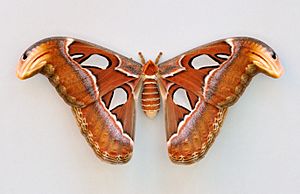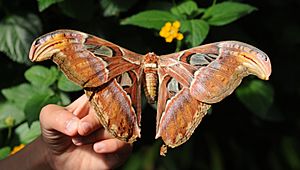Atlas moth facts for kids
Quick facts for kids Atlas moth |
|
|---|---|
 |
|
| Female | |
| Scientific classification | |
| Kingdom: | |
| Phylum: | |
| Class: | |
| Order: | |
| Family: | |
| Genus: |
Attacus
|
| Species: |
A. atlas
|
| Binomial name | |
| Attacus atlas (Linnaeus, 1758)
|
|
The atlas moth (scientific name: Attacus atlas) is a truly amazing insect. It's one of the biggest moths in the world! You can find these giant moths in the warm, tropical forests of Southeast Asia. They are famous for their huge wings, which have one of the largest surfaces of any moth.
Contents
Discovering the Atlas Moth
The atlas moth was first described by the famous scientist Carl Linnaeus in 1758. He named it Attacus atlas. The name "Atlas" might come from the Titan Atlas in Greek myths, known for his great size. It could also be named after the unique map-like patterns on its wings.
What Makes Atlas Moths Special?
Atlas moths are known for their incredible size. They have one of the largest wing surfaces of any moth. Their wingspan can reach up to 25 to 30 centimeters (10 to 12 inches). That's about the length of a ruler!
Amazing Wing Patterns
The wings of an atlas moth are a beautiful mix of brown, orange, white, and pink colors. They have clear, triangle-shaped "windows" on each wing. These windows look like they are made of glass. The patterns on the wings also help the moth blend in with its surroundings.
Snake-Head Wing Tips
One of the most interesting features of the atlas moth is the tips of its front wings. They look very much like the head of a snake! This clever trick helps scare away predators, making them think the moth is a dangerous snake.
Life Cycle of the Atlas Moth
Like all moths, the atlas moth goes through a complete metamorphosis. This means it changes a lot during its life.
From Egg to Caterpillar
The life of an atlas moth starts as a tiny egg laid on a leaf. After a short time, a small caterpillar hatches from the egg. These caterpillars are usually pale green with a powdery white coating. They have small, spiky bumps on their bodies.
The caterpillar's main job is to eat, eat, and eat! It munches on the leaves of various plants, like citrus trees and cinnamon. As it eats, it grows bigger and bigger. It sheds its skin several times as it gets too large for its old skin.
The Cocoon Stage
Once the caterpillar is fully grown, it stops eating. It then builds a large, silken cocoon around itself. This cocoon is usually attached to a branch or leaf. Inside the cocoon, the caterpillar changes into a pupa. This is a resting stage where the amazing transformation into a moth happens.
The Adult Moth
After about a month, the adult atlas moth emerges from its cocoon. The adult moth has no mouth! This means it cannot eat or drink anything. Its only purpose is to find a mate and lay eggs. Because they cannot eat, adult atlas moths only live for about one to two weeks. They rely on the energy stored up from when they were caterpillars.
Where Do Atlas Moths Live?
Atlas moths live in the warm, tropical and subtropical forests of Southeast Asia. You can find them in countries like China, India, Malaysia, and Indonesia. They prefer dense forests where there are plenty of trees for their caterpillars to eat.
Images for kids
-
Antennae of a male atlas moth
-
Habitat on Mount Kinabalu
See also
 In Spanish: Mariposa atlas para niños
In Spanish: Mariposa atlas para niños







